Module 1: Overview - Facilitator's Notes
Preventing CAUTI in the ICU Setting
Slide 1. Preventing CAUTI in the ICU Setting
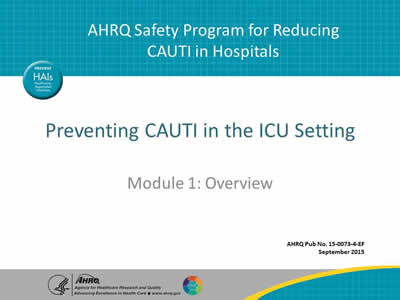
Say:
"Preventing CAUTI in the ICU Setting" is a four-module program designed for intensive care unit, or ICU, nurses to gain a sense of confidence and demonstrate competence in catheter-associated urinary tract infection, or CAUTI, prevention concepts and techniques. It is a part of the AHRQ Safety Program for Reducing CAUTI in Hospitals.
The education format will be a mix of concepts and case studies. From time to time, the narrator will ask that you pause the presentation to think about questions as they relate to your facility's practices and processes. Although you aren't required to do this, you might find that it will help you understand how to apply information to your work.
You are now about to view Module 1: Overview.
Slide 2. Learning Objectives
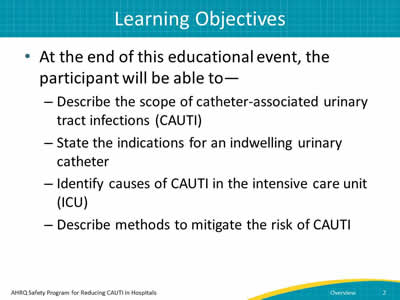
Say:
The learning objectives for this entire training are as follows.
After you listen to all the modules, you will be able to—
- Describe the scope of CAUTI
- State the indications for an indwelling urinary catheter
- Identify causes of CAUTI in the ICU
- Describe methods to mitigate the risk of CAUTI
Slide 3. Scope of the Problem
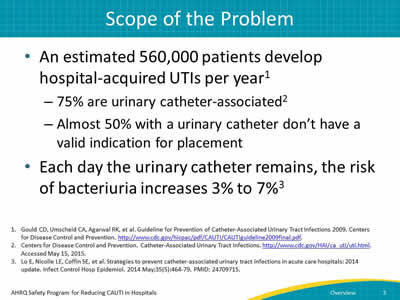
Say:
So, what is the scope of the CAUTI problem? Large. In fact, around 560,000 patients develop UTIs per year from hospital stays, and of those, three-quarters are associated with urinary catheters. However, nearly half of those patients with a urinary catheter don’t have a valid indication for placement.
For those with catheters, the risk of bacteriuria increases 3 to 7 percent every day the catheter remains in place.
Slide 4. Scope of the Problem
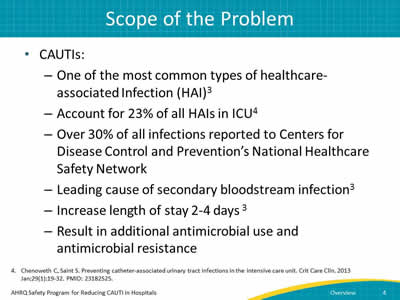
Say:
With that in mind, it’s easy to understand why CAUTIs are one of the most common types of healthcare-associated infections, or HAIs. They represent one-fourth of all HAIs in intensive care units and nearly one-third of all infections reported to the Centers for Disease Control and Prevention’s National Healthcare Safety Network, and are the leading cause of secondary bloodstream infections.
For a patient who develops a CAUTI, it can mean a longer stay in the hospital, by as many as 4 days. From a public health standpoint, CAUTIs pose another risk, namely that their frequency leads to additional antimicrobial use and antimicrobial resistance.
Slide 5. HICPAC Indications for a Urinary Catheter
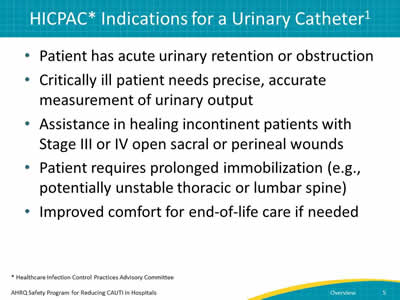
Say:
But if overuse of catheters is a problem, what do we know about guidelines related to catheter use? In 2009, the CDC’s Healthcare Infection Control Practices Advisory Committee, or HICPAC, described appropriate indications for catheter use.
- Use 1: Patient has acute urinary retention or obstruction
- Use 2: Critically ill patient needs precise, accurate measurement of urinary output
- Use 3: Assistance in healing incontinent patients with Stage III or IV open sacral or perineal wounds
- Use 4: Patient requires prolonged immobilization (e.g., potentially unstable thoracic or lumbar spine)
- Use 5: Improved comfort for end-of-life care if needed
Slide 6. HICPAC Indications for a Urinary Catheter
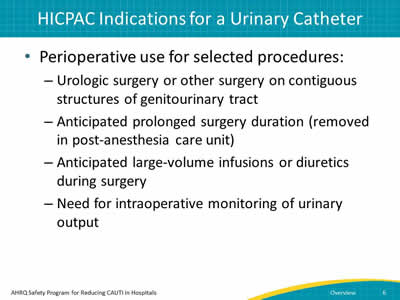
Say:
In the perioperative setting, catheters are used for selected procedures:
- Urologic surgery or other surgery on contiguous structures of genitourinary tract
- Anticipated prolonged surgery duration (removed in post-anesthesia care unit)
- Anticipated large-volume infusions or diuretics during surgery
- Need for intraoperative monitoring of urinary output
Slide 7. Challenges With Catheter Use in the ICU
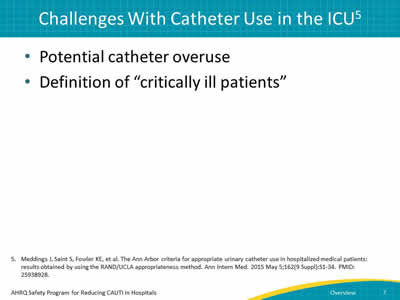
Say:
But catheter use in the ICU has two main challenges.
The first is potential catheter overuse. A recent national survey of catheter placement practices in acute care hospitals demonstrated that many hospitals reported placing catheters for reasons not included in the HICPAC list of appropriate indications.
The second is that the term “critically ill patients” is not well defined. We know that just because a patient is in the ICU, the patient may not require a urinary catheter.
Slide 8. Recent Consensus Document
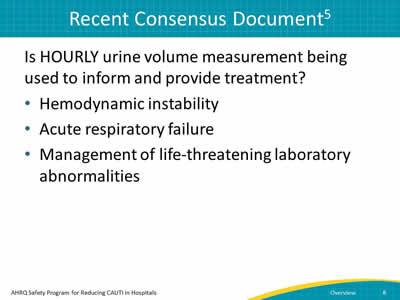
Say:
A recent document published by Meddings and colleagues took a deep dive into appropriateness issues. After reviewing the literature, a 15-member multidisciplinary panel used a standardized process to rate scenarios as appropriate, inappropriate, or of uncertain appropriateness. This was used as a means to further explore the broad definition of critically ill patients who would need a urinary catheter.
The following questions and indications may be helpful in guiding ICUs in developing protocols for urinary catheter use.
- Is a urinary catheter still appropriate for your ICU patient? If your patient does not have one of the following criteria, you may consider removing the catheter.
- Is HOURLY urine volume measurement being used to inform and provide treatment? For example, does the patient have hemodynamic instability that requires hourly or multiple daily titrations per day, ongoing fluid resuscitation, vasopressors, inotropes, or diuretics?
- Does the patient have acute respiratory failure that requires invasive ventilation and hourly urine output assessment for frequent (i.e. every 4 hours) decisions regarding diuretic administration?
- Another consideration to leave the urinary catheter in place would be the need for hourly measurement of urine studies or urine volumes needed to manage life-threating laboratory abnormalities.
Slide 9. Consensus
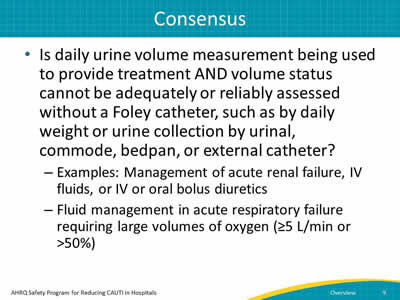
Say:
In some instances, you might need to do a daily urine volume measurement to provide treatment. One instance is management of patients with acute renal failure, intravenous or IV fluids, or IV or oral bolus diuretics or fluid management in acute respiratory failure requiring large flow rates of oxygen of greater than or equal to 5 liters per minute or 50 percent. However, in many cases, you can determine volume status through other means, such as by daily weight or urine collection by urinal, commode, bedpan, or external catheter.
Slide 10. Stop and Think

Say:
Take this opportunity to stop this presentation and think about some questions:
- What are you doing in your facility, as related to catheter use?
- Are your practices well defined and consistent with current recommendations?
- Why or why not? Do they need further clarification?
- What barriers keep you from following the recommendations?
After you’ve given this some thought, press play to resume viewing the presentation.
Slide 11. Variables Impacting CAUTI in ICU Settings
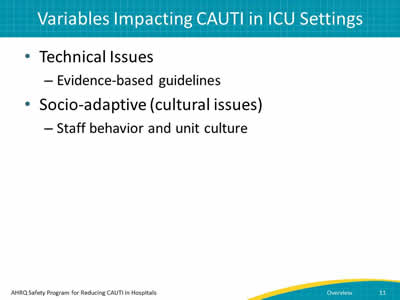
Say:
Many facilities don’t follow these recommendations, or confusion exists due to ambiguity. Often, two variables impact compliance.
First are technical issues, specifically those related to evidence-based guidelines.
Second are the more challenging socio-adaptive, or cultural, issues.
We’ll talk about each one individually.
Slide 12. Technical Challenges

Say:
In some instances, resistance to changing catheter use practices comes from the belief that there’s no real reason to change them. However, you can challenge that by using evidence-based guidelines.
But how do you know if this is an issue? To determine if staff lack a deeper understanding of the impact of CAUTI, ask yourself:
- Has your facility summarized the evidence and disseminated to the frontline staff?
- Is there a lack of knowledge of prevention and prevalence of CAUTI in ICU?
- Does your facility evaluate and share information on CAUTI rates and device use ratios?
As you would imagine, staff want to provide the best care possible for their patients, so sharing science-based information will help them understand the importance of appropriate urinary catheter usage.
Slide 13. Adaptive or Cultural Changes

Say:
So, how do you know if you are facing a cultural challenge? When you ask a caregiver why they are using a urinary catheter, do they say “we’ve always done it this way” or “it’s standard practice for all patients”? Are nurses reluctant to remove urinary catheters even when the patient no longer meets criteria for a catheter? Are physicians engaged in CAUTI prevention?
Behavior-based beliefs are a challenge. It is important to first engage care providers and connect the situation directly to the impact on the patient. There are strategies that may be helpful. For example—
Can we connect the dots to harm? Can we share stories of patients who were harmed by a urinary catheter? Perhaps you have a patient who became septic because of a CAUTI, or who developed a Clostridium difficile infection as a result of antibiotic treatment for a CAUTI. Storytelling is a powerful tool.
Slide 14. Etiology of CAUTI

Say:
Understanding how CAUTIs develop can help with educating fellow staff members.
CAUTIs develop from a patient’s colonic or perineal flora, generally because of bacteria on the hands of the patient and medical personnel. Harmful microbes enter the bladder via two routes:
- Extraluminal: Around the external surface
- Intraluminal: Inside the catheter
The daily risk of bacteriuria with catheterization is estimated between 3 percent and 7 percent. By day 30 with the catheter, the risk is at 100 percent. Obviously, the best way to prevent CAUTIs is not to insert a urinary catheter in the first place. But as discussed earlier, there are cases of ICU patients whose conditions require a continued need for a urinary catheter.
Slide 15. Patient Factors

Say:
However, there are also times when we have to be extremely careful about catheter use. For instance, ICU patients who are critically ill may be at high risk for infection due to underlying comorbid conditions. Add an invasive device such as a urinary catheter, and you are increasing their risk for infection. Going a step further, if such a patient develops a CAUTI, then using an antibiotic to treat the infection may put them at even higher risk for Clostridium difficile infection and multiple drug-resistant organisms.
Slide 16. Behavioral or Cultural Factors
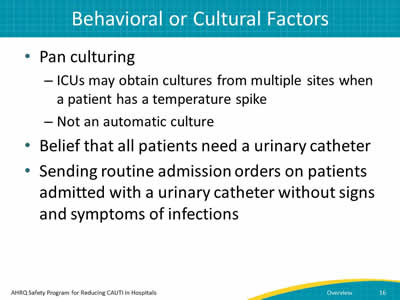
Say:
Many ICUs obtain cultures from multiple sites when a patient has a temperature spike. However, the temperature increase should warrant a critical evaluation of the patient rather than an automatic culture.
As we discussed earlier, the daily risk of catheter colonization grows between 3 percent and 7 percent per day, so we know that unnecessary culturing without signs or symptoms of UTI could lead to detection of microorganisms in the urine that may not be reflective of a true urinary tract infection. This can lead to inappropriate use of antibiotics.
Understand that historically, care providers thought that just being in the ICU meant a patient needed a catheter.
Slide 17. Methods for Mitigating Risk
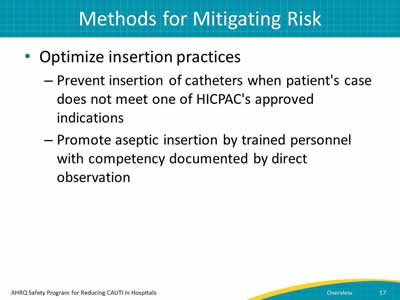
Say:
But what can you do about it? Obviously, the best thing you can do is avoid use of a catheter unless the patient meets one of HICPAC's approved indications.
But if you must use one, then you must also optimize insertion practices by ensuring the catheter is inserted aseptically by trained personnel. Competency in aseptic insertion should be documented by direct observation.
Slide 18. Methods for Mitigating Risk
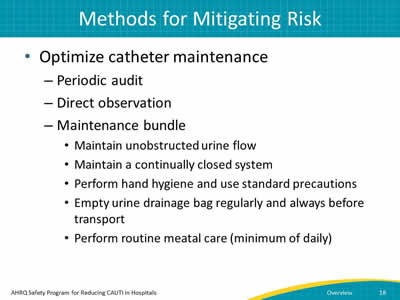
Say:
It is important to monitor not only outcomes of care, but the processes of care as well. Periodic audits and direct observation are some ways to do this. When assessing the indication on a daily basis, ask the question, does my patient still need a urinary catheter?
In the previous slide we talked about aseptic insertion, so now let’s discuss how we maintain the catheter in what is sometimes referred to as the maintenance bundle:
- Maintain unobstructed urine flow
- Maintain a continually closed system
- Perform hand hygiene and use standard precautions before touching the catheter
- Empty urine drainage bag regularly and always before transport
- Perform routine meatal care (minimum of daily)
Slide 19. Methods for Mitigating Risk
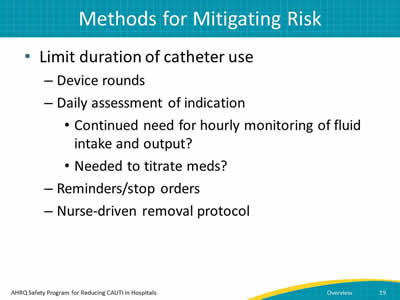
Say:
Another obvious way to limit CAUTI risk is to limit the length of time a urinary catheter is indwelling. How can you do this? One easy way is through device rounds so that you do a daily assessment of indication.
Automatic reminders and stop orders are ways to remind physicians to discontinue the catheter if no longer needed or to reorder it. These practices keep the length of catheter use to a minimum.
Another way is to implement a nurse-driven removal protocol. Many hospitals have adopted protocols that permit the nurse to remove the catheter without a specific order if a patient meets certain criteria.
Slide 20. Methods for Mitigating Risk
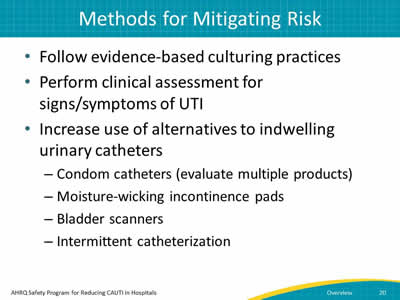
Say:
We talked earlier about indications for insertion, so now let’s discuss other ways to decrease the risk of CAUTI. For instance, establish evidence-based culturing practices.
You should also perform clinical assessments for signs/symptoms of a UTI.
You also have alternatives to indwelling urinary catheters, and you should consider increasing their use. Alternatives include—
- Condom catheters (evaluate multiple products)
- Moisture-wicking incontinence pads
- Available bladder scanners
- Intermittent catheterization
And these are just a few of the many options that exist.
Slide 21. Demonstrate Team-Based Practices

Say:
Above all, reducing the risk of CAUTI requires a team approach through communication with your fellow staff. Have one-on-one conversations to provide a safe environment to support frontline staff by openly communicating with one another.
You can also drill down on CAUTI using the “Learning From Defects” tool on the AHRQ Web site and review each case with frontline staff. Ask staff, what could we have done differently? How can we prevent the next CAUTI?
Frontline staff and unit leaders need time and resources to work together to investigate causes of CAUTI and brainstorm solutions to prevent them from recurring.
Nurses and physicians can also work together to develop ICU-specific indications for catheter use.
Remember that with some careful thought and attention, you can make a difference.
Slide 22. References
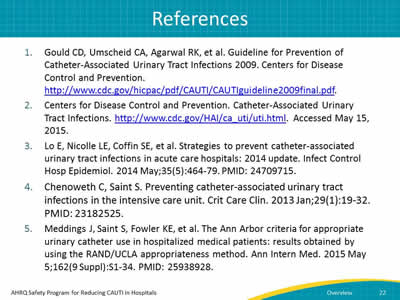
No narration needed



